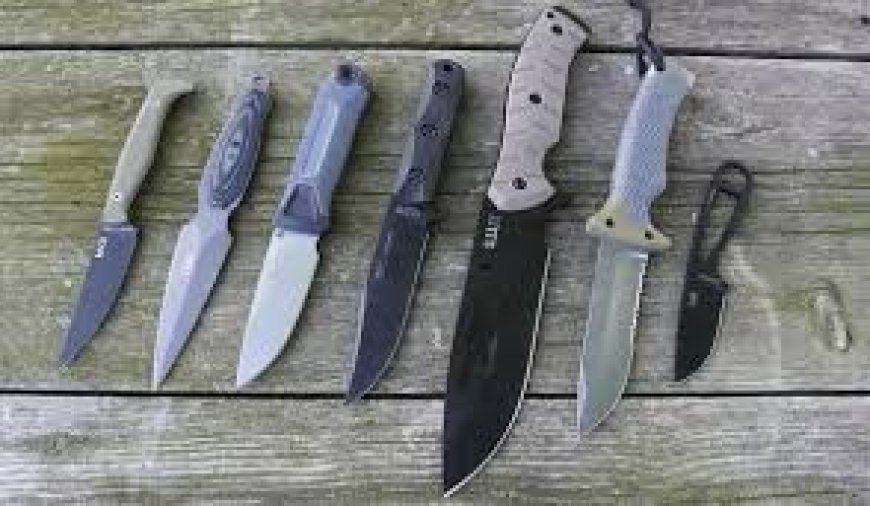A Complete Guide to the Best Uses for Fixed Blade Knives in Daily and Rugged Situations
Fixed blade knives are a timeless tool, known for their strength, reliability, and wide range of uses. Whether you're hiking through the wild, cooking in the kitchen, or handling everyday tasks, a fixed blade knife is more than just a survival accessoryits a daily companion.
In the United States, fixed blade knives have a strong following among outdoor lovers, home cooks, and even everyday users who value dependable tools. In this guide, well explore the best uses for fixed blade knives in both everyday and tough situations, and how they differ from more specialized knives like Chefs Knives.
What Are Fixed Blade Knives?
Fixed blade knives are knives with blades that do not fold or slide. The blade is permanently fixed in the open position and usually extends deep into the handle, offering more strength and stability. Because of this design, they tend to be stronger and more durable than folding knives.
These knives are often the preferred choice in outdoor environments, but their uses extend far beyond the woods. From kitchens to workspaces, their solid build and versatility make them essential tools for many Americans.
Everyday Uses of Fixed Blade Knives
1. Home and Utility Tasks
Fixed blade knives come in handy around the house. Theyre excellent for opening packages, cutting rope, trimming plants, or even light crafting. Their sharpness and solid grip allow you to make clean, quick cuts without worrying about the blade snapping or folding.
Compared to pocket knives, fixed blade knives are safer for heavier-duty tasks. Their sturdy handle gives better control, reducing the chance of accidents.
2. Kitchen Chores
While Chefs Knives are designed specifically for food preparation, fixed blade knives can still play a supporting role in the kitchen. Their thick, sharp edges are great for slicing frozen foods, cutting through bones, or performing tasks where precision is less important than raw cutting power.
Many chefs also use compact fixed blade utility knives to do simple tasks like trimming meat, peeling vegetables, or opening tough food packaging. Though they are not replacements for traditional Chef's Knives, they complement them well in a busy kitchen.
3. Gardening
Fixed blade knives are excellent gardening tools. They are useful for digging small holes, cutting twine, trimming roots, and even dividing plants. A strong, pointed blade can make quick work of tough soil or stubborn roots, making gardening more efficient.
Rugged and Outdoor Uses
1. Camping
Camping is one of the most common reasons people in the USA purchase fixed blade knives. These knives can be used for cutting firewood, prepping food, clearing brush, or building a shelter. The strength and durability of a fixed blade knife make it a campers best friend.
Unlike folding knives, fixed blades dont have moving parts, which makes them more reliable in outdoor environments. Theyre easier to clean and less likely to break when used for challenging tasks.
2. Hunting and Fishing
Hunters rely on fixed blade knives for skinning game, cutting meat, and even protection. The solid blade is ideal for cutting through thick hides or bones. Many hunters prefer a drop point or clip point blade design for skinning and precision work.
Fishermen also benefit from fixed blade knives. A good knife can be used to clean fish, cut lines, or prepare bait. Its rugged build ensures it can handle water and dirt without wearing down quickly.
3. Survival and Bushcraft
In survival scenarios, few tools are more valuable than a fixed blade knife. These knives are used for making shelter, starting fires, and crafting tools or weapons. Many survival knives feature a full tang (where the blade runs through the handle), which adds strength and durability.
Bushcraft enthusiasts also use fixed blade knives for carving, wood splitting, and general wilderness tasks. Their robust design makes them dependable in even the harshest environments.
Comparing Fixed Blade Knives with Chefs Knives
While both types of knives serve important roles, they are made for very different purposes. Chef's Knives are designed for precision slicing, chopping, and food preparation. They often feature a long, curved blade that allows for rocking motion cutting on a chopping board.
Fixed blade knives, on the other hand, are more versatile in non-kitchen environments. Theyre built for strength rather than finesse. Thats not to say they cant be used in a kitchen, but they are better suited for rougher or outdoor tasks.
The key takeaway is: use Chef's Knives for cooking, and Fixed Blade Knives for everything else. That way, youll always have the right tool for the job.
How to Choose the Right Fixed Blade Knife
With so many styles available, choosing the right fixed blade knife can be overwhelming. Here are a few things to consider when buying one:
Blade Material
High-carbon steel blades are strong and hold an edge well but may rust without care. Stainless steel is rust-resistant and great for wet environments like fishing or cooking.
Blade Shape
Different blade shapes serve different purposes. A drop point is great for general tasks, while a tanto or spear point may be better for tactical or piercing tasks.
Handle Grip
The handle should fit comfortably in your hand. Rubber or textured grips offer better control, especially when the handle is wet or dirty.
Full Tang vs. Partial Tang
A full tang blade, where the metal runs through the entire handle, is stronger and more reliable. This is especially important for survival or heavy-use scenarios.
Sheath
A good sheath protects the blade and makes it easier to carry. Leather and synthetic sheaths are common, and some even attach to belts or packs for quick access.
Laws and Safety Around Fixed Blade Knives in the USA
Before carrying a fixed blade knife, it's important to check local and state laws. Some areas restrict blade length or where you can legally carry the knife. Generally, carrying a fixed blade in public places (like schools or government buildings) is not allowed.
When transporting your knife, keep it in a sheath and stored safely. Always use it responsibly and never in a threatening manner.
Caring for Your Fixed Blade Knife
Proper care keeps your fixed blade knife performing well for years. Here are a few simple tips:
-
Clean after each use. Especially after food prep or exposure to moisture.
-
Sharpen regularly. A dull knife is more dangerous than a sharp one.
-
Store safely. Keep it in a sheath or knife block to avoid accidents.
-
Oil the blade. Lightly oiling prevents rust and corrosion, especially on carbon steel.
Whether you're a camper, hunter, chef, or just someone who values good tools, taking care of your knife is just as important as choosing the right one.
Conclusion
Fixed blade knives are an essential tool for many Americansfrom home cooks and gardeners to adventurers and survivalists. Their durability, reliability, and range of applications make them one of the most versatile tools you can own.
While Chef's Knives dominate the kitchen, fixed blade knives shine in outdoor and rugged environments. But as weve seen, they also have a place in everyday life. By understanding their uses and taking care of them properly, you can ensure your fixed blade knife serves you well for many years.
Whether you're cutting through rope on a camping trip or prepping a fish by the lake, a well-chosen fixed blade knife is more than just a toolit's an investment in safety, preparedness, and efficiency.





































